The approximate geographical locations of where the coins were issued can be seen on this map
(identify coins by their coin numbers). Coins of large empires are located in the area of the presumed capital cities.

|
|
|

|
Coin #39:
Sultans of Malwa, Nasir Shah, Silver tanka, 1500-1510
Legend /
Legend
Weight: 4.45 gm, Diameter: 19 mm.
Ref: GG M136 |
|
As it happens, I have no coin from the 15th century included here,
but rather have four coins from the 16th century. Nevertheless, coins 39 and 40 are representative of 15th century coins as they exhibit the style and type of 15th century coins
of the respective dynasties: coin 39 being a silver tanka of the Malwa Sultanate and coin 40 being a silver sasnu of the Kashmir Sultanate.
We had seen in our discussion of coins 36 and 37 that the slave dynasty had lost its grip on the Delhi Sultanate, which had passed into the hands of Ala-ud-din Khilji around the
end of the 13th century. The Sultanate had expanded into western India (including Gujarat and Malwa) and even further south into the realm of the Yadavas of Devagiri, the
Hoysalas of Dorasamudra and the Pandyas of Madura. Thus Ala-ud-din Khilji brought the Delhi Sultanate to its maximum extent. Besides being a great general, Ala-ud-din was
also an able administrator. However, he failed to establish an orderly succession. Soon after his death in 1316, a succession struggle broke out and, by 1320, the Delhi
Sultanate passed into the hands of the Tughluq dynasty.
The Tughluqs ruled Delhi for the remainder of the 14th century, locked in an on-going struggle to preserve their kingdom. It was a losing battle. Bengal broke away and the
Bengal Sultanate became established as an independent kingdom (see coin 37 above). The southern provinces also broke away and the new Hindu kingdom of Vijayanagar
was established in 1336, along with Muslim-ruled sultanates in Bijapur, Ahmadnagar and Golconda. The death blow occurred in 1398, with the invasion of Timur (Tamerlane), a
Mongol, descendent of Genghis Khan, and the ruler of a large kingdom that encompassed modern Iran, Afghanistan, Uzbekistan and Tajikistan. Timur advanced to Delhi,
looting and pillaging along the way, and sacked Delhi late in 1398. Some 100,000 Hindu inhabitants were slaughtered and much property was looted. In the complete disarray
that followed, the provinces of Malwa and Gujarat also broke away as the viceroys in each of these states established independent sultanates. The Delhi Sultanate itself,
weakend as it was, came under the control of the Timurid Sayyid dynasty.
The Malwa and Gujarat Sultanates lasted through the 15th century and well into the 16th century, when each was absorbed into the newly expanding Mughal empire by the
great emperor Akbar. Coin 39 is an example of Malwa coinage from very early in the 16th century, displaying the very fine style of calligraphy that developed there. More coins of
the Malwa sultans can be seen on the Malwa Sultans page and coins of the Gujarat Sultans can be seen on
the Gujarat Sultans page.
To see the approximate geographical location of where this coin was issued, look for the number 39 on this map. |

|
Coin #40:
Sultans of Kashmir, Shams ud-din Shah, Silver sasnu, 1537-1538
Legend: al-sultan al-a'zam shams al-din shah /
Within central ornamental diamond: zarb Kashmir,
frozen date 842 spelled out in margins
Weight: 6.16 gm, Dimensions: 16 x 16 mm.
Ref: GG K92 |
|
We last mentioned Kashmir in our discussion of
coin 23. In the 7th century, Kashmir was in the hands of the Hunnic Kidarites. Over the next six or seven centuries, the
kingdom was ruled by a succession of Hindu dynasties. What is particularly remarkable about this entire period is that the coinage remained remarkably stable ... the same basic
design (similar to coin 23) persisted throughout this period, with only the names of the kings or queens changing over time.
Hindu rule lasted until the middle of the 14th century. An adventurer from Swat named Shah Mirza came to Kashmir, became a minister in the royal court, and eventually usurped
the throne in 1346, thereby establishing the Kashmir Sultanate. This dynasty lasted through the 15th and most of the 16th century, eventually falling, like Malwa and Gujarat, to
the Mughal emperor Akbar's conquering armies.
Through this entire period, the Sultanate issued a stable coinage based on a weight standard different from all its neighbors and its past: the silver sasnu of approximately
6.2 gm. Coin 40 is an example, in particularly fine style, of this coinage. More coins of the Kashmir sultans can be seen on the
Kashmir Sultans page.
To see the approximate geographical location of where this coin was issued, look for the number 40 on this map. |

|
Coin #41:
Mughal: Babur (Zahir ud-din Muhammad), Silver tanka or shahrukhi, c. 1526-1530
Legend /
Legend
Weight: 4.62 gm. Diameter: 22-23 mm |
|
Indian history of the 16th century is dominated by the arrival of the
Mughals. The founder of the dynasty, Babur, was a descendent of Timur (Tamerlane) and Genghis Khan, and son of the ruler of Fergana in modern Uzbekistan. However, his
father died when he was just 12 years old, and he was dispossessed of his inheritance by ambitious nobles who usurped the throne. For the next 30 years, Babur attempted to
acquire a kingdom somewhere or other, attempting to take at various times (and temporarily succeeding sometimes) Fergana, Samarkand, Kabul, and so on. However, despite
temporary successes, he was unable to hold a kingdom for any length of time. Eventually, he decided to invade India. The Sayyids, who were a Timurid dynasty, had lost the
Delhi Sultanate to the Lodis, and so Babur used his Timurid ancestry as a justification for laying claim to the throne in Delhi. With help from the Safavid ruler in Persia, Babur was
successful in defeating the Lodis at the first Battle of Panipat in 1526, thereby creating the Mughal empire based in Delhi.
Babur spent the next few years consolidating and expanding his position, which he had done by the time of his death in 1531. Coin 41 is an issue of Babur in the style of Timurid
coins from Central Asia of that period. The coin does not name a mint, and may have been struck at Lahore. More coins of the early Mughals can be seen on
this page.
To see the approximate geographical location of where this coin was issued, look for the letter H on this map. |
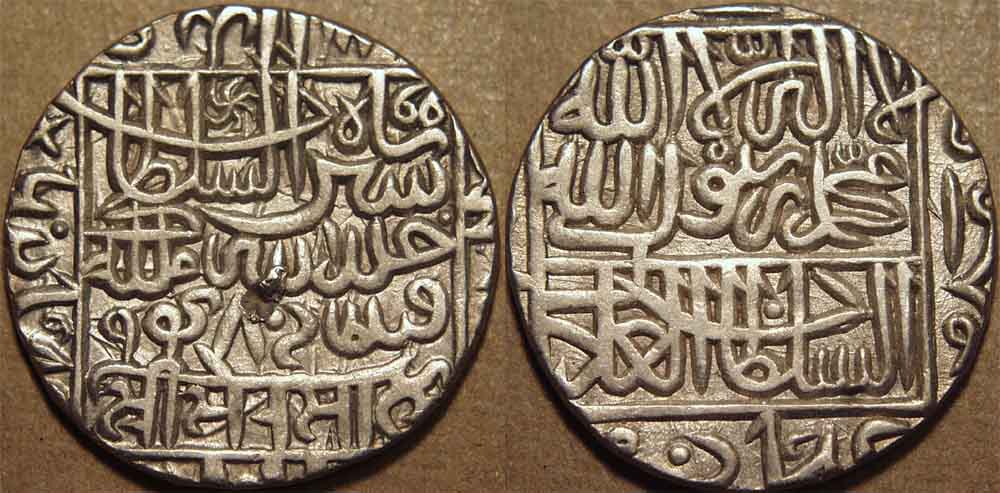
|
Coin #42:
Suris: Sher Shah Suri (1538-45) Silver rupee, Jahanpanah type, dated to 1540-41
Legend, including name in Nagari sri ser sah and AH date 947 ( = 1540-41 CE)
Legend, Shahada
Weight: 11.28 gm., Diameter: 27 mm., Die axis: 11 o'clock |
|
Babur, according to Timurid custom, had ordered that his empire
be divided upon his death amongst his sons, of whom Humayun was the eldest. A power struggle ensued. At the same time, Humayun attempted to expand his empire to Malwa
and Gujarat, which had been independent of Delhi since the time of Timur, 1398. Taking advantage of the uncertain situation, Sher Shah, an Afghan adventurer who had taken
up a military career, challenged Humayun and defeated him. Sher Shah thus established the Suri dynasty, with a kingdom stretching from the Indus to Bengal. He forced
Humayun to seek shelter at the Persian court.
Sher Shah was a very able administrator and, although he ruled for only five years, created an administrative structure that was adopted and maintained by the Mughals. Among
his many reforms was a complete overhaul of the monetary system. As part of this, Sher Shah introduced a new denomination of silver coin: the rupee. This was the first time this
denomination was used and, obviously, its use has continued to this day. Coin 42 is an early rupee of Sher Shah, dated 947 of the Hijri era, equivalent to 1540-41 CE. More
coins of the Suris can be seen on the Suri Dynasty page.
To see the approximate geographical location of where this coin was issued, look for the letter G on this map. |
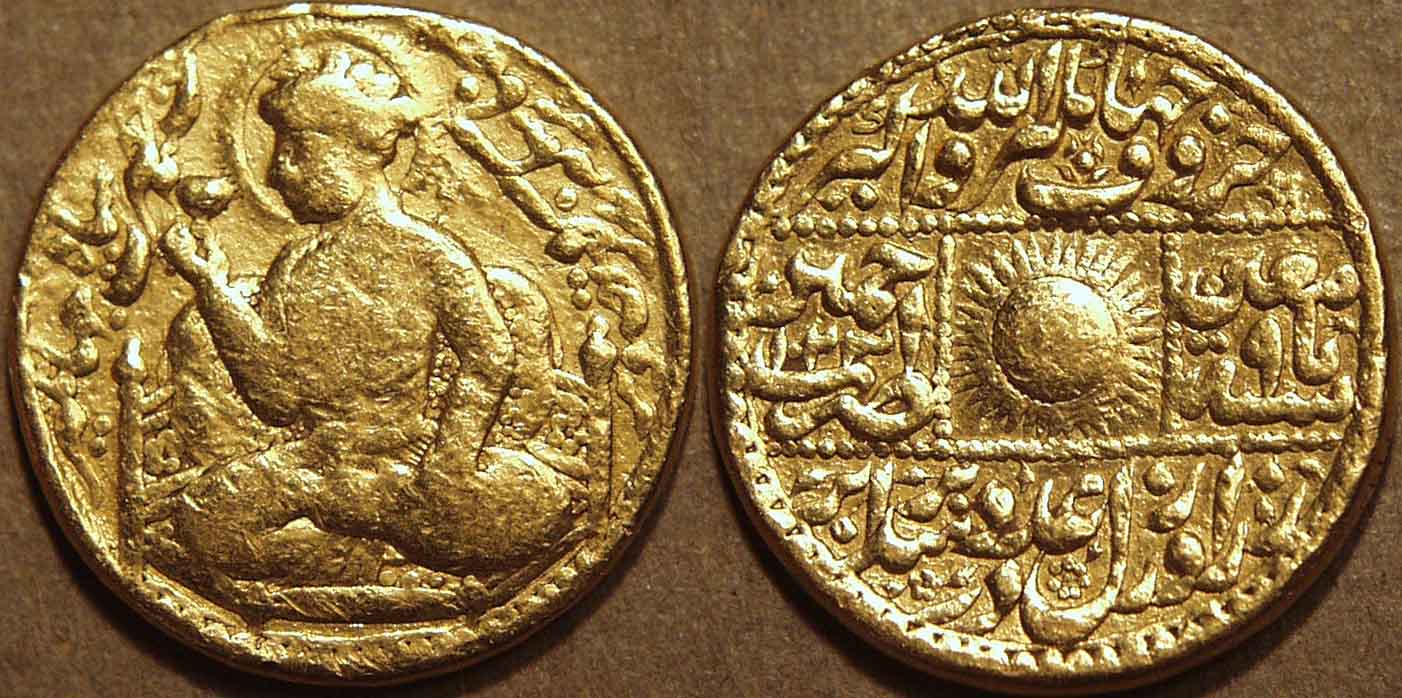
|
Coin #43:
Mughal: Jahangir (Muhammad Nur-ud-din Salim), 1605-27, Gold mohur, Ajmer
Jahangir enthroned, holding wine goblet /
Radiate sun, surrounded by legends in four compartments
AH date 1023 (= 1614-15 CE), regnal year 9
Weight: 10.83 gm. Diameter: 21 mm Die axis: 1 o'clock |
|
Sher Shah was succeeded by his son, Islam Shah, whose rule
lasted 10 years during which the Suri-controlled Delhi Sultanate enjoyed a period of relative peace. However, upon Islam Shah's death, instability set into the kingdom and
Humayun, watching from the safety of the Safavid court in Peria, saw his opportunity. With the help of the Persian emperor, he marched into India with a large army and
regained his throne. His triumph was short-lived though, as he died the following year.
Humayun was succeeded by his son Akbar. Most historians regard Akbar as the greatest Mughal emperor. He greatly expanded the empire to include Afghanistan, Pakistan,
northern India and Bangladesh. More important, he followed policies of reconciliation between Hindus and Muslims, even attempting to found his own amalgamated religion, so
his rule ushered in a more peaceful atmosphere. One sign of his religious tolerance is that his favorite queen was the daughter of a Rajput king, the Hindu princess of Jodhpur.
Akbar enjoyed a long reign from 1556 to 1605 and was succeeded by Jahangir, the son his Hindu queen bore him. Jahangir was also a capable ruler but the area in which he
really made his mark was in his patronage of the arts. When returning to India from Persia, Humayun had brought with him artists from the Persian court. In this way, a tradition of
fine art had developed in the Mughal court, and Jahangir was to take it to new heights, particularly in miniature painting. The artistic ferment was also to be reflected in the
coinage. Following Islamic strictures against portraying the human form, all Mughal coins up to (and even after) this point were purely calligraphic. Jahangir, however, introduced
a few rare types which featured his portrait. Coin 43 is an example of such a coin. It shows Jahangir seated on his throne and holding a wine goblet (horrors!) in his right hand.
More coins of Jahangir can be seen on the Jahangir page.
To see the approximate geographical location of where this coin was issued, look for the letter H on this map. |
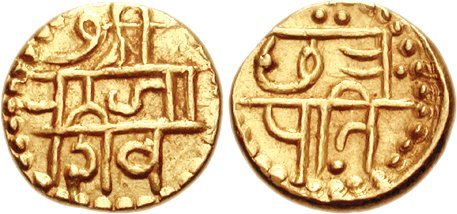
|
Coin #44:
Marathas: Chhatrapati Sivaji, Gold hon, c. 1674-80
Nagari legend: sri / raja / shiva /
Nagari legend: chhatra / pati
Weight: 2.81 gm. Diameter: -- mm Die axis: 7 o'clock
(Photo courtesy CNG) |
|
Jahangir ruled from 1605 to 1627 and was followed by his son, Shah Jahan (1627-58). Mughal architecture perhaps reached its greatest height under Shah Jahan, the builder of
the Taj Mahal and many other significant buildings in Agra, Delhi and Lahore. Although Shah Jahan lived until 1666, he ruled only until 1658 as he was deposed by his son
Aurangzeb.
Aurangzeb brought the long period (roughly 100 years) of relative tranquility to an end. He embarked on a new period of major expansion, pushing the Mughal frontier further
west in Afghanistan and further south in peninsular India. He also ended the period of religious tolerance, imposing heavy taxes on Hindus, instituting sharia law, and
encouraging conversion to Islam. A result of his heavy-handed policy was increased resistance from the local population. One leader who emerged in this new situation was the
Maratha leader and warrior Shivaji. The son of a minor noble, Shivaji was to raise a large army that challenged the mighty Mughals. Coin 44 is a rare gold coin of Shivaji in which
he is named as Sri Raja Shiv on one side and Chhatrapati, or Lord of the Kshatriyas, on the other. Shivaji's struggle against the Mughals, continued by his sons
after his death, probably played a large part in the slow demise of the empire after Aurangzeb's death.
To see the approximate geographical location of where this coin was issued, look for the number 44 on this map.
|
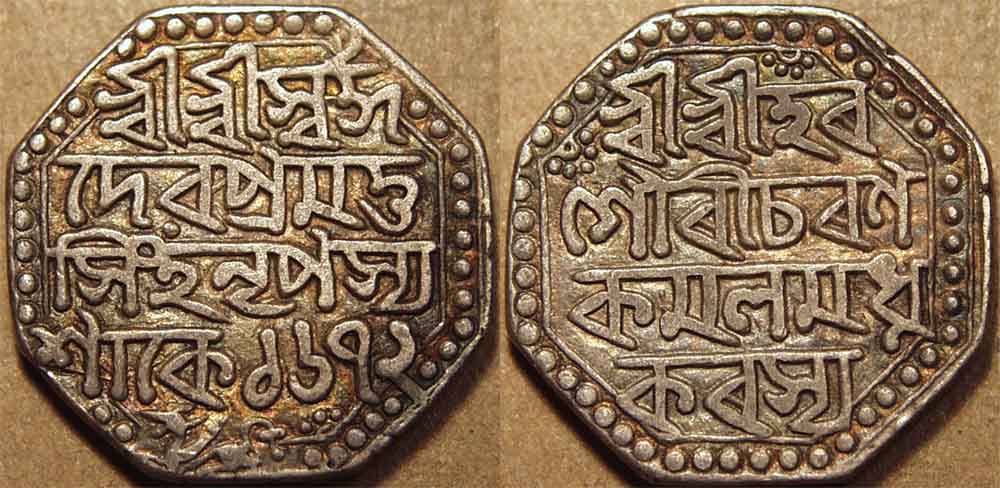
|
Coin #45:
Kingdom of Assam: Pramatta Simha, Silver rupee, S. 1672 (= 1750 CE)
Four-line Assamese legend: sri sri swarga / deva pramatta / simha nripasya /
sake 1672, lion left below /
Four-line Assamese legend: sri sri hara / gauri charana / kamala madhu / karasya
Weight: 11.23 gm. Diameter: 24 mm Die axis: 6 o'clock
Reference: MNI 2474 var, KM 122 |
|
Aurangzeb died in 1707, having lost a large part of his army and also having emptied much of the Mughal treasury in his military campaigns. So, although he had greatly
expanded the Mughal empire, this expansion had come at a heavy price. Mughal rule continued nominally for another 150 years, but its power was slowly waning, as new
powers emerged around the periphery and the colonial powers began to eat away at its core.
Coin 45 is a silver rupee from Assam, a kingdom on the northeast frontier of India that had managed to stay more or less outside the Mughal empire through most of its history.
The coin shows an odd combination of influence and independence. On the one hand, both sides of the coin are dominated by legends, following the Islamic custom of
eschewing images. On the other hand, the language of the legends is Sanskrit, written in an Assamese variation of Nagari letters, the shape is a highly unusual octagon, and in
fact a small image of a lion has crept into the design at the bottom of the obverse. This coin is typical of issues from Assam covering a long period of almost 300 years, from the
16th to the 19th century.
To see the approximate geographical location of where this coin was issued, look for the number 45 on this map. More coins of the Kingdom
of Assam can be seen on the Assam page.
|
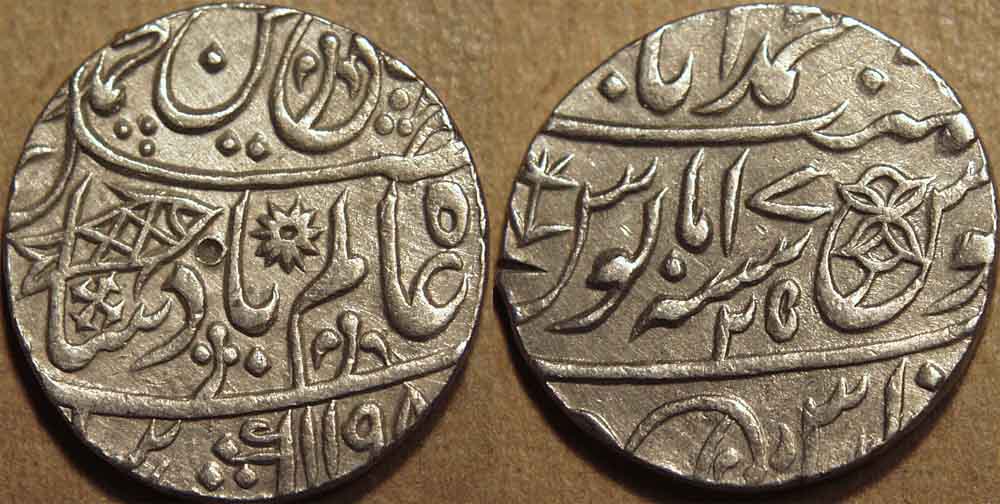
|
Coin #46:
British India, Bengal Presidency, Silver rupee, Banaras, AH 1198 (= 1784-85 CE)
Legend, including AH date 1198 (= 1184-85 CE)
Legend, including mint name Muhammadabad Banares,
mintmark fish and double regnal years 17 and 25
Weight: 11.31 gm. Diameter: 24 mm Die axis: 5 o'clock
Reference: Pridmore ---, KM --- (unlisted) |
|
The main event in Indian history of the 18th century was the accession to power of the colonial powers, particularly the British. The Portuguese explorer Vasco da Gama had
achieved in 1498 what Christopher Columbus had set out to do in 1492: discover a sea route to India. The Portuguese established their first factory in Cochin in 1503 and
started to issue coins in 1511 in Goa. They had the India trade all to themselves for over a century.
That changed in the 17th century, however, as the major European powers began to jockey for dominance in the Indian trade. The
Dutch established their first settlement in Pulicat in 1610. The British East India Company (chartered in 1600) opened its first factory in Mazulipatam (near Madras) in 1611,
but soon abandoned it due to conflict with the Dutch. They opened a factory at Surat on the west coast in 1621, returned to the Madras area in 1626, and established their first
factories in the Bengal area in 1633. The Danes arrived in Tranquebar in 1620. Finally, the French established their first
factory in Pondicherry in 1674.
Initially meant to be trading posts, the European settlements soon became fortified military bases and the European powers began to maneuver for territorial position against one
another and against the local Indian powers. After the death of Aurangzeb in 1707, the Mughal empire weakened considerably and many of the local viceroys became
independent and started to wage war on one another to gain dominance. The British seized the opportunity to advance their position. A particular situation presented itself in
1757 to allow the British to seize control of Bengal. The autonomous nawab of Bengal, Siraj-ud-Daula (still nominally a vassal of the Mughal emperor) was faced with an invasion
on his western front by the Afghan Ahmad Shah Abdali, who had just captured and looted Delhi before advancing on Bengal. Siraj had sent a large part of his army to face this
invasion. The British then bribed disgruntled elements of the remaining troops, particularly the recently sacked commander in chief, Mir Jafar, to stay out of the battle, and they
then engaged the forces of Siraj-ud-daula at Plassey. Out of 50,000 troops that Siraj put on the field, apparently only about 5,000 actually fought. They still outnumbered the
British contingent, but not overwhelmingly so, and the British prevailed. The Battle of Plassey marks the beginning of the conquest of India by the British.
Over the next few decades, the British expanded their realm inexorably towards Delhi. Coin 46 is a British issue of this period. Dated in 1784-85, and issued in Banares, the coin
still names the Mughal emperor Shah Alam as the issuer. However, by this time Banares had fallen to the British and they controlled the mint. The fish symbol on the obverse of
the coin marks it as an East India Company issue. Thus the British were maintaining the fiction of the emperor's supremacy, while actually controlling things behind the scenes.
That is why they were issuing coins in the Mughal style rather than a British one. This coin, therefore, is representative not only of the early British India coinage, but also of late
Mughal style as well.
To see the approximate geographical location of where this coin was issued, look for the number 46 on this map. More coins of British India
can be seen on the British India pages.
|

|
Coin #47:
Kingdom of Mysore, Tipu Sultan, AE 2-Paisa, 1782-1799 CE
Elephant right with raised trunk, flag and legend above
Legend, including mint Patan (for Srirangapatnam, or Seringapatan)
Weight: 23.22 gm. Diameter: 33 mm
Reference: KM 124.3 var |
|
Although the British did not receive much resistance from the
crumbled remnants of the Mughal empire, they did face challenges from other forces: the Marathas, the Sikhs and the kingdom of Mysore. This last kingdom had been built
upon the remnants of the old Vijayanagar empire. In the mid-18th century, a capable general in the Mysore army, Haidar Ali, rose to prominence and gained control of the
kingdom in all but name. He faced off against the British in successive wars, as did his son, Tipu Sultan, after Haidar's death in 1782. Tipu Sultan, dubbed the "Tiger of Mysore,"
proved a formidable adversary, but was eventually killed in battle in 1799.
Tipu was a very able administrator and undertook extensive administrative reforms, including of the coinage. He introduced new denominations and new coin types of very high
artistic quality that are in high demand from collectors. Coin 47 is one such: a handsome copper double paisa, with a beautifully engraved elephant on the obverse and a
Persian legend on the reverse.
To see the approximate geographical location of where this coin was issued, look for the letter F on this map. More coins of Tipu Sultan
can be seen on the Tipu Sultan page. |
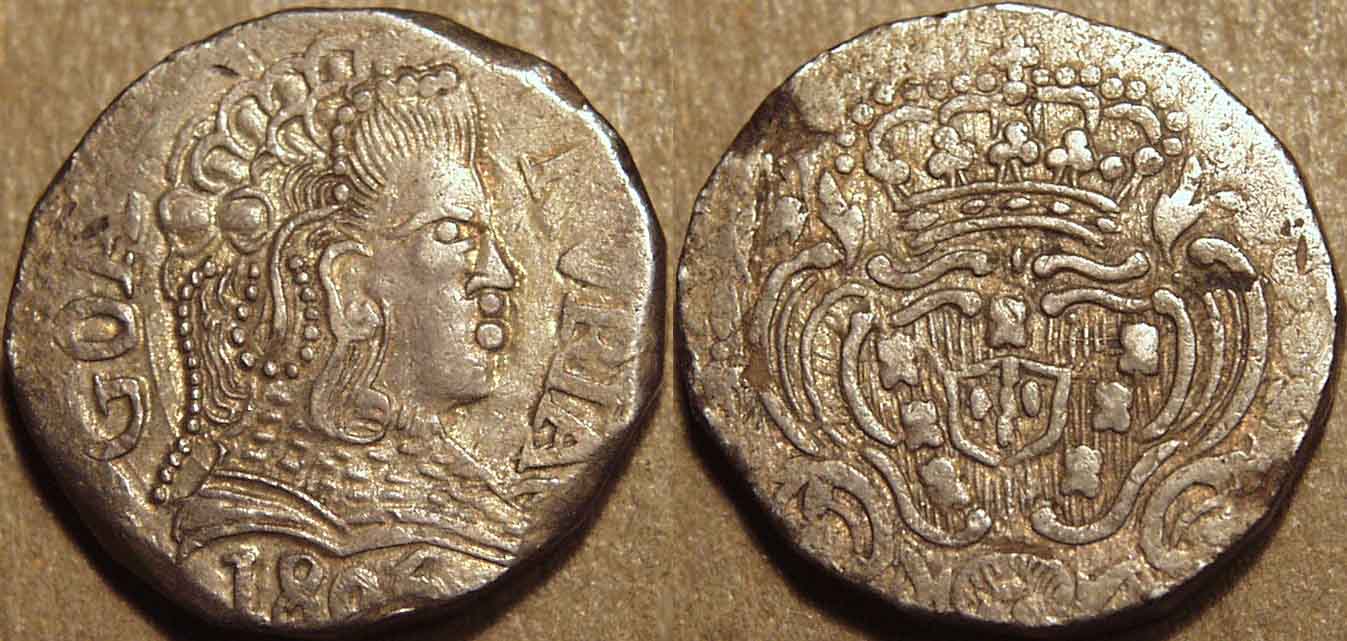
|
Coin #48:
Portuguese India, Maria I, Silver rupee, Goa, 1805
Crowned bust of queen right, GOA at left, MARIA at right, date 1805 below
Queen's coat of arms
Weight: 10.74 gm. Diameter: 21 mm
Reference: MNI 1420 |
|
Coin 48 is an issue of Portuguese India: a silver rupee from Goa, dated 1805, featuring a bust of the then Portuguese queen, Maria I, on the obverse and her coat-of-arms on
the reverse. The Portuguese never issued coins on the Indian pattern. Their coins all look European in design, and this was reflected in their behavior as well. They stayed
pretty well confined in their enclaves and did not participate too much in the conflicts raging on the sub-continent. A high proportion of the local populations in the Portuguese
territories converted to Christianity and they were not well integrated with the rest of Indian society. When Indian independence was achieved in 1947, the Portuguese territories
were not included. After attempting to persuade the Portuguese to leave peacefully of their own accord, the independent Indian government undertook a military action in 1961
to finally expel the Portuguese. They had been the first European power to arrive in India, and were the last to leave.
To see the approximate geographical location of where this coin was issued, look for the number 48 on this map.
|
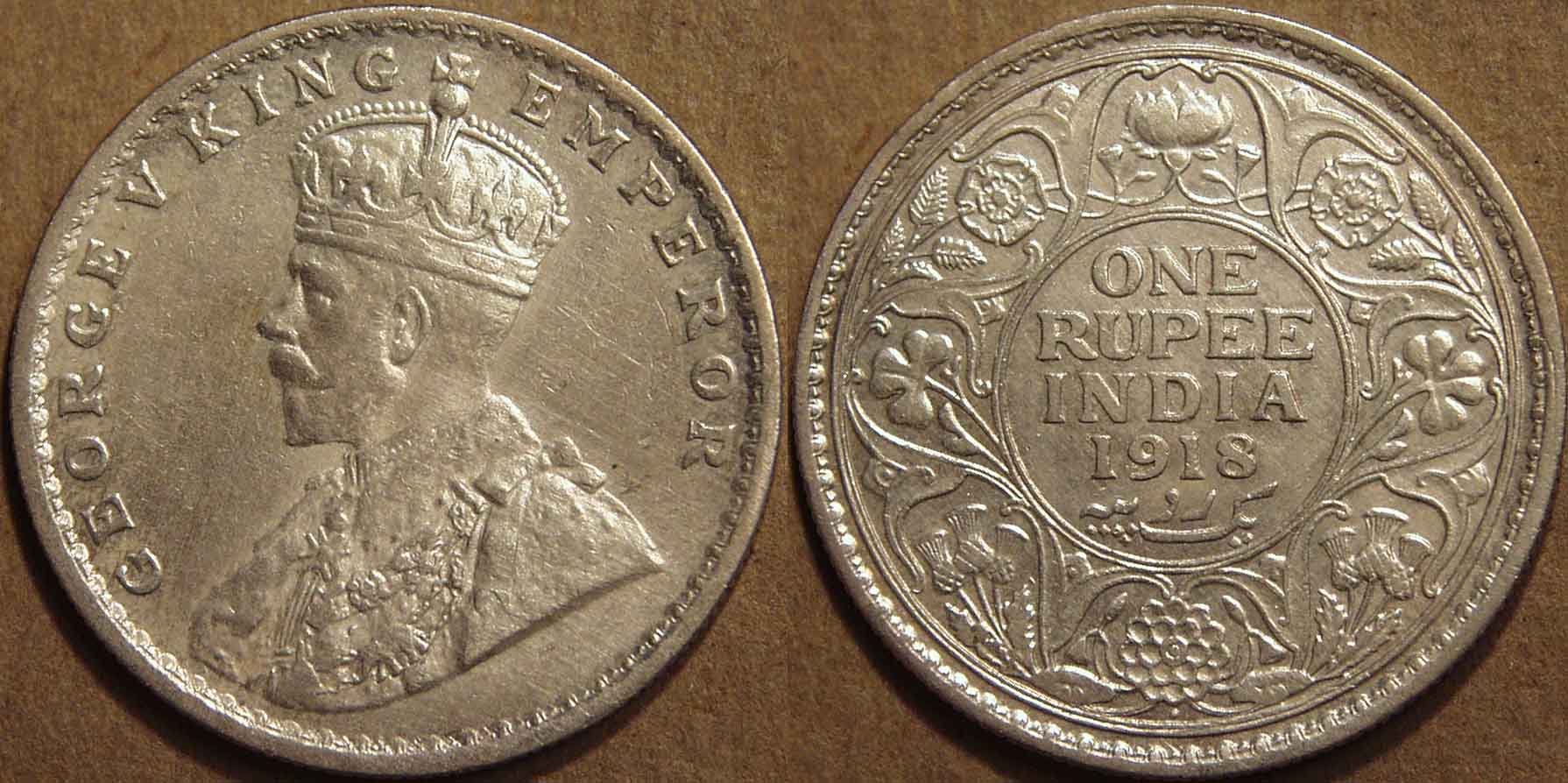
|
Coin #49:
British India, Imperial Series, George V, Silver rupee, 1918
Crowned bust of king left, legend around: George V King Emperor
Within circle, One Rupee India 1918, wreath around
Weight: 11.56 gm. Diameter: 31 mm
Reference: MNI 2021 |
|
As we saw in the discussion of coin 46, the British, acting through the East India Company, embarked on a policy of
territorial acquisition in the mid-18th century and this policy met with considerable success. The area under British control kept expanding through the 19th century. However,
until 1835, British coinage in India was on the local pattern (such as coin 46), reflecting the fiction that fiduciary power continued to rest with the local princes and nawabs.
This changed in 1835, when all British coinage in the sub-continent was converted to a universal system based on British prototypes. The bust of the British monarch was
placed on the obverse with his or her name and title (initially William IIII King and later Victoria Queen) and the legend East India Company was placed on the reverse
along with denominational and other information.
Through this period, the Mughal emperor still officially ruled from Delhi, even though actual power rested with the British Governor-General. Things came to a head in 1857,
when a rebellion against British rule occurred. This rebellion, called the "Indian Mutiny" by the British and the "First War of Indian Independence" by Indian nationalists,
persuaded the British government that it was time to make administrative changes. The Mughal emperor was formally deposed and sent to exile in Burma. About half the land in
the country was declared to be under British rule while the other half was left nominally in the hands of local princes (the Princely States), vassals of the British. The coinage from
the British mints continued to follow the pattern of the post-1835 unified coinage, except that the legend East India Company was replaced simply by India.
Finally, in 1876, the British monarch, Victoria, was declared Empress of India and so the obverse of the coinage started to reflect the imperial title, such as Victoria Empress. Coin
49 belongs to this series: a 1918 silver rupee issued during the reign of George V King Emperor. It reflects the types of all British coinage from the post-1835 period and this style
continued until Indian and Pakistani independence in 1947. There is nothing particularly important about this particular specimen; it was chosen because it was essentially the first
coin in my collection, acquired when, as a young boy, I begged a group of "ancient" coins from my grandmother! |
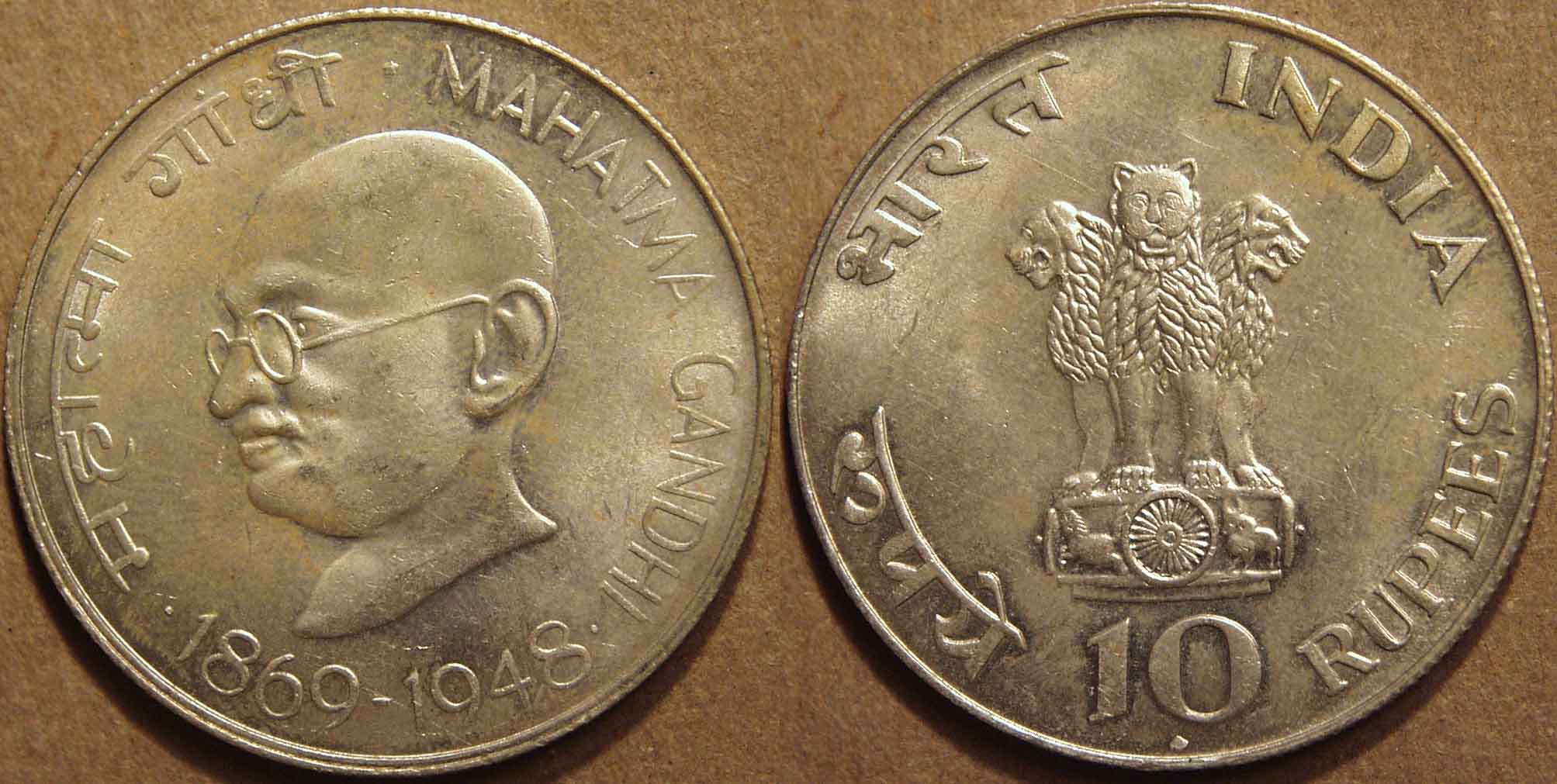
|
Coin #50:
India (Republic), Gandhi Centennial, Silver 10 rupees, 1969
Head of Gandhi three-quarter left, name in Hindi and English above: Mahatma Gandhi
Life-span years below: 1869-1948
Lion capital seal of the Government of India, Bharat India above,
Denomination: 10 rupiye rupees below
Weight: 15.01 gm. Diameter: 34 mm
Reference: MNI 2077 |
|
The history of India in the 20th century is quite well-known. The struggle for independence from British rule started around the turn of the century and gathered steam under the
leadership of Mahatma Gandhi. As we know, Mahatma Gandhi based his approach to India's freedom struggle on the philosophy of ahimsa, or non-violence. The British
eventually agreed to leave peacefully and, under the terms of the agreement, British India was divided into two countries. At the stroke of midnight on August 14-15, 1947, the
countries of India and Pakistan became independent dominions of the British empire, self-governing, but nominally acknowledging the British monarch as the head of state. A
few years later (India, 1950, and Pakistan, 1956), both countries cut this last formal tie and became independent republics.
Naturally each country started to issue its own national coinage after independence. Coin 50 is an issue of the Indian government, minted in 1969 to commemorate the 100th
anniversary of Mahatma Gandhi's birth. This coin neatly ties together streams from ancient and modern Indian history. It features the head of Mahatma Gandhi on the obverse and
the Indian government's official seal on the reverse. It is worth noting that, in a bow to India's long history, the Indian seal is taken from the top of a pillar installed by the Mauryan
emperor Ashoka the great (273-232 BCE (see the discussion for coin 5), often regarded as the greatest Indian ruler of all
time. Ashoka had renounced violence and had spread the Buddha's teachings of non-violence throughout the land. And Mahatma Gandhi had employed this philosophy of
non-violence to peacefully achieve Indian independence from British rule. So here we have the two great exponents of non-violence, Ashoka and Gandhi, united on one coin.
 |
 |
 |
Conclusion |
 |
 |
 |
These pages have presented 50 coins, roughly two from each of the last 25 centuries, to illustrate the great variety of Indian coin types. At the same time, the coins have served as
vehicles to summarize a broad overview of Indian political history over this 2,500 year period. We see a land in a constant state of flux, subject to a continuous stream of outside
influences. And yet we see a culture that is resilient, a melting pot able to withstand and absorb these influences, to render them "Indian." I personally believe that this cultural
resilience is seen even today. As modern India develops economically, on a largely Western model, she preserves a strong culture that is resisting being swallowed by western
culture. In this way, it appears that India will preserve at least a major part of her cultural DNA and will be able to offer the future a richer mene pool, or cultural gene pool, from which
to draw.
|
|
|
|